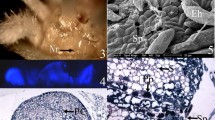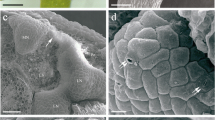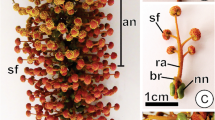Abstract
Nectar was collected from the extrafloral nectaries of leaf stipels and inflorescence stalks, and phloem sap from cryopunctured fruits of cowpea plants. Daily sugar losses as nectar were equivalent to only 0.1–2% of the plant's current net photosynthate, and were maximal in the fourth week after anthesis. Sucrose:glucose:fructose weight ratios of nectar varied from 1.5:1:1 to 0.5:1:1, whereas over 95% of phloem-sap sugar was sucrose. [14C]Sucrose fed to leaves was translocated as such to nectaries, where it was partly inverted to [14C]glucose and [14C]fructose prior to or during nectar secretion. Invertase (EC 3.2.1.26) activity was demonstrated for inflorescence-stalk nectar but not stipel nectar. The nectar invertase was largely associated with secretory cells that are extruded into the nectar during nectary functioning, and was active only after osmotic disruption of these cells upon dilution of the nectar. The nectar invertase functioned optimally (phloem-sap sucrose as substrate) at pH 5.5, with a starting sucrose concentration of 15% (w/v). Stipel nectar was much lower in amino compounds relative to sugars (0.08–0.17 mg g-1 total sugar) than inflorescence nectar (22–30 mg g-1) or phloem sap (81–162 mg g-1). The two classes of nectar and phloem sap also differed noticeably in their complements of organic acids. Xylem feeding to leaves of a range of 14C-labelled nitrogenous solutes resulted in these substrates and their metabolic products appearing in fruit-phloem sap and adjacent inflorescence-stalk nectar. 14C-labelled asparagine, valine and histidine transferred freely into phloem and appeared still largely as such in nectar. 14C-labelled glycine, serine, arginine and aspartic acid showed limited direct access to phloem and nectar, although labelled metabolic products were transferred and secreted. The ureide allantoin was present in phloem, but absent from both types of nectar. Models of nectary functioning are proposed.
Similar content being viewed by others
References
Baker, D.A., Hall, J.L., Thorpe, J.R. (1978) A study of the extrafloral nectaries of Ricinus communis. New Phytol. 81, 129–137
Bentley, B.L. (1977) Extrafloral nectaries and protection by pugnacious bodyguards. Ann. Rev. Ecol. Syst. 8, 407–427
Durkee, L.T. (1982) The floral and extrafloral nectaries of Passiflora. II. The extrafloral nectary. Am. J. Bot. 69, 1420–1428
Eleftheriou, E.P., Hall, J.L. (1983) The extrafloral nectaries of cotton. 1. Fine structure of the secretory papillae. J. Exp. Bot. 34, 103–119
Elias, T.S. (1972) Morphology and anatomy of foliar nectaries of Pithecellobium macradenium (Leguminosae). Bot. Gaz. 133, 38–42
Elias, T.S., Gelband, H. (1976) Morphology and anatomy of floral and extrafloral nectaries in Campsis (Bignoniaceae). Am. J. Bot. 63, 1349–1353
Elias, T.S., Rozich, W.R., Newcombe, L. (1975) The foliar and floral nectaries of Turnera ulmifolia L. Am. J. Bot. 62, 570–576
Fahn, A. (1979) Ultrastructure of nectaries in relation to nectar secretion. Am. J. Bot. 66, 977–985
Findlay, N., Mercer, F.V. (1971) Nectar production in Abutilon. II. Submicroscopic structure of the nectary. Aust. J. Biol. Sci. 24, 657–664
Gottsberger, G., Schrauwen, J., Linskens, H.F. (1984) Amino acids and sugars in nectar, and their putative evolutionary significance. Plant Syst. Evol. 145, 55–77
Grout, B.W.W., Williams, A. (1980) Extrafloral nectaries of Dioscorea rotundata Poir.: their structure and secretions. Ann. Bot. 46, 255–258
Gunning, B.E.S., Hughes, J.E. (1976) Quantitative assessment of symplastic transport of prenectar into the trichomes of Abutilon nectaries. Aust. J. Plant Physiol. 3, 619–637
Kuo, J., Pate, J.S. (1985) The extrafloral nectaries of cowpea (Vigna unguiculata (L.) Walp.). I. Morphology, anatomy and fine structure. Planta 166, 15–27
Lüttge, U. (1977) Nectar composition and membrane transport of sugars and amino acids. Apidologie 8, d305–319
O'Dowd, D.J., Catchpole, E.A. (1983) Ants and extrafloral nectaries: no evidence for plant protection in Helichrysum spp.-ant interactions. Oecologia (Berlin) 59, 191–200
Pate, J.S., Peoples, M.B., Atkins, C.A. (1983) Post-anthesis economy of carbon in a cultivar of cowpea. J. Exp. Bot. 34, 544–562
Pate, J.S., Peoples, M.B., Atkins, C.A. (1984) Spontaneous phloem bleeding from cryopunctured fruits of a ureide-producing legume. Plant Physiol. 74, 499–505
Peoples, M.B., Atkins, C.A., Pate, J.S., Murray, D.R. Nitrogen nutrition and metabolic interconversions of nitrogenous solutes in developing fruits of cowpea (Vigna unguiculata (L.) Walp). Plant Physiol., in press
Schnepf, E. (1964) Zur Cytologie und Physiologie pflanzlicher Drüsen. 4. Licht- und elektronenmikroskopische Untersuchungen an Septalnektarien. Protoplasma 58, 137–171
Ziegler, H. (1965) Die Physiologie pflanzlicher Drüsen. Ber. Dtsch. Bot. Ges. 78, 466–477
Zimmermann, J.G. (1932) Über die extrafloralen Nektarien der Angiospermen Bot. Zentralbl. A49, 99–196
Author information
Authors and Affiliations
Rights and permissions
About this article
Cite this article
Pate, J.S., Peoples, M.B., Storer, P.J. et al. The extrafloral nectaries of cowpea (Vigna unguiculata (L.) Walp.) II. Nectar composition, origin of nectar solutes, and nectary functioning. Planta 166, 28–38 (1985). https://doi.org/10.1007/BF00397382
Received:
Accepted:
Issue Date:
DOI: https://doi.org/10.1007/BF00397382




